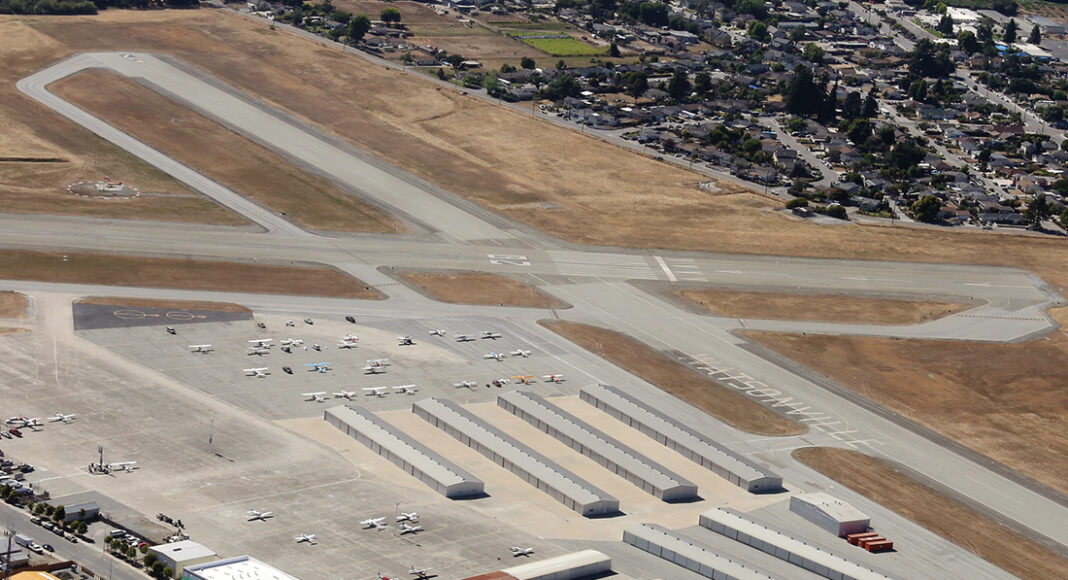The Watsonville City Council in March will consider either shortening the crosswind runway at Watsonville Municipal Airport—or deactivating it altogether—which is the airport’s effort to meet Federal Aviation Administration (FAA) guidelines and keep its pilots safe.
That was the message to the City Council Tuesday night from Watsonville Municipal Airport Director Rayvon Williams, who was presenting the newly minted 2023 Airport Master Plan.
Either move would offer “significant growth potential,” lessening restrictions in the airport’s safety zones and potentially opening up portions of the city for development such as housing and businesses, Watsonville Principal Planner Justin Meek said.
The council unanimously passed the 324-page plan, which is a blueprint for development and operations for the next 20 years.
They also approved an addendum to the 2003 environmental impact report and the Airport Layout Plan.
Included in the master plan update—which was paid for with a $550,000 grant from the FAA—is potentially lengthening the 4,500-foot main runway to 5,181 feet, reconfiguring several taxiways, improving airfield drainage and boosting security for the pedestrian and vehicle access gates.
The 2023 master plan update—which totals $163.8 million in projects over the 20-year plan horizon—also predicts an increased number of operations, defined as takeoffs and landings, from 55,000 in 2021 to 89,900 in 2040.
Williams pointed to the airport’s importance to the community, which includes bringing $67 million to the local economy and 452 jobs.
It also served as a command center during the 1989 Loma Prieta earthquake and hosted President Joe Biden earlier this year, he said.
“We’re going to do whatever we can to make sure this critical resource continues,” he said.
Between 2017-2019, Williams applied for $2.5 million in grants to refurbish the runway and taxiways, with new striping, marking and lighting.
As the airport worked with the FAA in 2018 to install satellite-based technology, the federal agency told Williams that the shorter crosswind runway does not meet federal visibility standards for intersecting runways.
Since the airport does not have a control tower to direct operations, the intersecting runways require visual line of sight for takeoffs and landings to ensure safety.
While the FAA denied Williams’ request for an exception, the agency did agree to fund $500,000, part of what it would cost to make the so-called “threshold relocation,” a move complicated by the fact that it would go through an area populated with endangered tarplants.
But the FAA recently told Williams that it would no longer provide that funding for economic reasons.
This leaves Watsonville Airport with the need to address the visibility issue. So Williams presented four options to the council: 1) fund the runway by shortening it by 870 feet, 2) at virtually no cost shorten it by 1,590 feet or 3) deactivate it entirely.
All three would mitigate the visibility issue, Williams said.
A fourth option—deactivating the airport entirely—seemed to be a nonstarter with the council and with Williams, who said that that estimated 30-year, $30 million process would include relocating the businesses and pilots and a federal “paperwork nightmare.”
The council elected to bring back two options for further discussion in March: either shortening the runway by 1,590 feet or deactivating it.
Williams pointed out that none of the options would mean removing any part of the runway; it could still be used in emergencies, and could be reactivated if necessary.
Just 2% of the roughly 60,000 flights per year use the runway, Williams said. Still, it is a critical part of the airport, he added.
“Preserving that crosswind runway is extremely important, because we are a heavy training environment,” he said. “Fixed-wing training, rotary-wing training. A crosswind runway is key to safety. So closing that runway is really an anathema to me because it really does reduce the utility of the airport.”
Many of the council members viewed the options as a way to help address the ongoing affordable housing crisis, since shortening the runway—or deactivating it—would significantly reduce the airport safety zones and allow for development in more areas near the airport.
Councilwoman Kristal Salcido pointed to the city’s urban limit line, and to the state-mandated Regional Housing Needs Allocation, which requires Watsonville to plan for 2,250 affordable housing units by 2031.
“There are no easy decisions to be made here,” Salcido said. “All seven of us care the most about our population and the people of Watsonville. We are dealing with a very real housing crisis, and the opportunity to develop and make some hard decisions.”
Mayor Eduardo Montesino appeared skeptical of the airport’s benefits, and was leaning toward deactivating the runway.
“At some point, we’ve got to cut our losses and go for community opportunities,” he said. “And this is a community asset that has functioned in my view…as a playground for rich people to have an airplane.”
That drew ire from Tracy Laws, who serves as secretary for the Watsonville Experimental Aircraft Association.
Laws said her husband worked hard to earn his pilot’s license.
“We do not consider ourselves rich by any means,” she said. “We work hard, we live paycheck to paycheck and make sacrifices so he’s able to fly.”
Councilman Casey Clark described the airport as “critical infrastructure,” and expressed skepticism about deactivating the crosswind runway simply to open up development, since the city already has a hard time filling the space it has.
“I am all about development, but I have a major frustration with the way the city has been going for quite some time,” he said. “We have been building housing all over the place, but it has been all nonprofit low income and that doesn’t help our city with its tax base.”














wheher Casey Clark likes it or not, we need low cost housing for thousands of people who live in Watsonville. many of whom are unhoused. i approve of the plan and hope the city council will agree to it.